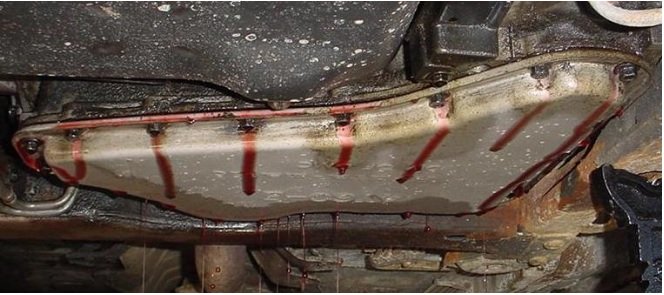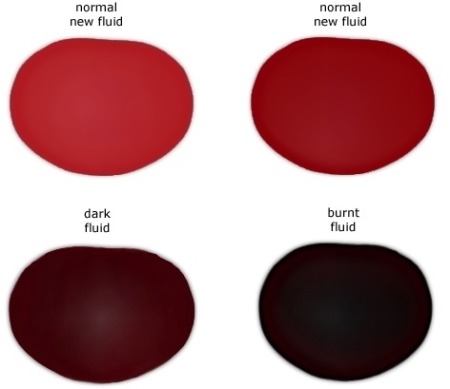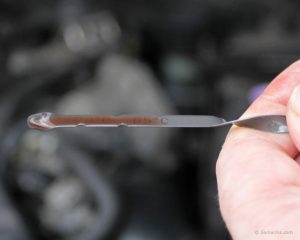1992 Ford F150 Trans Slips Going Into Third Gear UPDATED
1992 Ford F150 Trans Slips Going Into Third Gear
In This Guide
- Symptoms to Picket for
- 8 Common Causes of Transmission Slipping
- How to Set up Transmission Slipping
- If All Else Fails
- How to Prevent Slipping
- What to Read Next
- Over to You
A manual stays in a designated gear until a shift is performed by the commuter (manual) or the computer (automated). If yours is spontaneously slipping in and out of gear (or just popping into neutral) while driving, I don't need to tell you that this is a serious safe risk. When you step on the gas to accept a turn or pass a car, you demand power delivered to the wheels, end of story.
Need a replacement manual? Get an guess for replacement transmissions and local installation. Await up your transmission model past vehicle make and model.
What Transmission Do I Have?

 Slipping doesn't necessarily hateful that your transmission is about to fail, but it is a signal that you should become information technology looked at past a repair store. The clutch is most often the source of the trouble for manual transmissions, while in that location are many different causes for automatics.
Slipping doesn't necessarily hateful that your transmission is about to fail, but it is a signal that you should become information technology looked at past a repair store. The clutch is most often the source of the trouble for manual transmissions, while in that location are many different causes for automatics.
If your car is showing i or more of the symptoms of slipping listed beneath, you should get it look at equally soon equally possible. Driving with a slipping transmission is not recommended. In addition to being unsafe, continuing to drive tin can turn what might currently exist a pocket-size, like shooting fish in a barrel to gear up trouble into a much bigger consequence (or even transmission failure) that volition cost significantly more to fix.
In this guide, nosotros're going to look at several factors can cause a transmission to skid, the symptoms to watch for and what yous can do to solve the problem.
What Transmission Practise I Have?
Symptoms to Sentinel for
Slipping occurs when the transmission tries to change gear, causing it either fall back into the gear that it was previously in, or drop into neutral. Diagnosing the issue can be challenging, but here are the common signs to look for:
Automatic Transmission
- Check Engine Light is on
- Manual tries to upshift, then falls dorsum into a lower gear
- Transmission refuses to upshift
- Transmission falls into a lower gear, causing the engine to run at a high RPM
- Y'all stride on the gas, engine RPMs increment, only the vehicle speed doesn't
- Reverse won't engage
- Strange or burning smell
- Unusual noises when shifting
- Hard/crude gear changes
Manual Transmission
- Transmission won't get into gear
- Transmission inexplicably falls out of gear
- Unusual noises (similar grinding) during gear alter
eight Common Causes of Transmission Slipping
There are a number of possible causes, simply if you tin discover and fix the source of the problem speedily, you can forbid it from doing further damage to the transmission.
1) Depression Fluid Level
An automated manual relies on hydraulic pressure provided by transmission fluid to perform gear changes. If in that location isn't plenty fluid in the system, the transmission pump won't be able to create enough pressure to engage the next gear. Depression fluid levels may indicate a leak and tin can lead to overheating, and significant internal damage.
What to do: Check the Fluid Level
2) Transmission Fluid Leak
As we just explained, an automated transmission requires hydraulic pressure to alter gears. If yours is leaking, chances are at that place isn't enough fluid to shift gears without difficulty.
Sometimes, the problem can exist every bit unproblematic equally a bad transmission pan gasket, but it can besides exist faulty seals, ruptured fluid lines, a leak in the pan or a scissure in the torque converter.

Bank check the fluid level and wait at the underside of your automobile around the pan and on your drive for any sign of a leak.
What to practice: Seal Leaks With Lucas Fluid
3) Burnt/Worn Out Fluid
Over time, the composition of fluid breaks down, causing it to become thinner, darker and full of contaminants. If it is as well sparse or burnt it volition be ineffective at removing heat from the transmission and won't be able to keep the bands and clutches properly cooled. This will cause it to overheat, preventing it from shifting gears in a normal manner.

What to do: Change the Fluid
four) Broken or Worn Out Transmission Bands
In an automatic vehicle, metal bands are used to link the gears together. If one of these manual bands is worn or broken (often caused by overheating), that particular gear won't be able to engage properly, causing it to 'slip'.
What to do: Supervene upon or arrange the band(s)
5) Clutch Bug
Manual Transmission
The clutch is the cause of slipping in manual transmissions 90% of the fourth dimension (the other 10% tin can exist attributed to leaks). A clutch disc typically lasts from 20,000 to 200,000 miles depending on your driving habits.
The clutch uses friction cloth (like a brake pad) to take hold of onto the engine flywheel and basically separate the engine from the manual during a gear modify. If the friction material or throw-out bearing (the metal bit that moves the clutch when you footstep on the pedal) is worn, you lot won't be able to fully engage the clutch and shift gears.
What to do: Replace the clutch
Automated Transmission
An automatic vehicle uses clutch plates inside both the transmission and the torque converter to engage the diverse gears. If the friction textile on the plates is burnt or wears down, information technology might not be able to go into gear or smoothly shift gears and it may slip out of gear too.
What to do: Change the fluid and replace plates
half-dozen) Worn Out Gears
Worn gears can exist caused by normal article of clothing and tear (high mileage), ineffective fluid and overheating. Worn out gears don't work together properly, and this can cause harsh gear engagement, slipping out of gear, failure to engage a gear, and lots of grinding and clunking.
What to practice: Replace gear(s) or unabridged transmission
7) Solenoid Consequence
Solenoids are tiny electrically activated valves that control the flow of fluid within of a manual. Controlling the hydraulic pressure is essential to actuating a gear change, and so a faulty manual solenoid can crusade many bug, such every bit delayed shifts and failure to shift/engage a gear. If yous've already checked the fluid level, so the solenoids should be your doubtable. Utilise an OBD2 scanner to check for trouble codes and narrow downwards which solenoid is needs to be replaced.
What to practise: Check & supplant the solenoids
8) Torque Converter Consequence
A torque converter is a hydraulic circuit that transfers engine power to the transmission through hydraulic force per unit area. If it is damaged, in that location won't be enough pressure level to operate the valve body and modify/engage gears. A bad torque converter can likewise cause the engine to stall or sideslip out of the overdrive gear.
What to do: Cheque & replace the torque converter
How to Fix Transmission Slipping
If the slipping is being caused by ineffective fluid or low fluid level due to a leak, then yous may be able to fix the problem yourself past checking and irresolute the fluid or by repairing/plugging the leak.
Fixing more serious problems such as worn or broken bands, clutches and gears require removing and taking apart the transmission. These procedures should simply be attempted past those with significant auto repair feel.
Torque converter and solenoid replacements should exist left to professionals.
Depression Fluid Level – Cheque and Top-Off
 One of the easiest ways to prevent problems is to regularly monitor your fluid level. Once a month (every two weeks if you drive a lot), open the hood, locate the transmission dipstick, and cheque the ATF level. Always do this with the engine running, considering the internal pump has to be running in society to get an accurate reading.
One of the easiest ways to prevent problems is to regularly monitor your fluid level. Once a month (every two weeks if you drive a lot), open the hood, locate the transmission dipstick, and cheque the ATF level. Always do this with the engine running, considering the internal pump has to be running in society to get an accurate reading.
If the fluid appears dark, unusually thin, muddied, or has a burnt smell, have it changed immediately. If the it is below the optimum level indicated on the dipstick, add more fluid immediately to preclude farther damage.
There are several different types of ATF, so check your owner'south transmission to ensure that y'all get the right type of fluid (using the wrong kind of fluid can really crusade serious damage). Typically, you add fluid to an automatic manual by placing a funnel into the dipstick tube. If you're unsure, refer to your possessor's manual.
Click here for a complete tutorial
Burnt or Worn Out Fluid – Bleed & Refill
If your automatic transmission fluid needs to exist inverse, you can either do it yourself, or have a repair store practise information technology for you. Information technology can be a messy job, and it does require a bit of mechanical experience to do properly.
You can go step-past-footstep instructions in a Haynes-blazon store manual which are available at your local auto parts store, but the process goes similar this:
- Jack the vehicle up and unbolt the pan. The ATF will drain every bit you do this, and so place a catch pan and a tarp underneath it
- Remove and supervene upon the filter
- Scrape off the one-time transmission pan gasket and replace
- Bolt-on the pan and fill with ATF
- Commencement the vehicle and check for leaks
- Use copious amounts of kitty litter to cleanup the mess that you've just fabricated
Click hither for a complete tutorial
Fluid Leak – Replace Role(s) or Take it to a Store
If your transmission is leaking fluid, you need to discover the source. Experienced DIY-ers tin can normally research the vehicle-specific symptoms, replace the offending parts and fix the problem.
If you lot're not comfortable fixing the trouble yourself, discover a repair shop immediately. Otherwise, that little transmission leak could wind up creating a much bigger, more than costly problem.
If All Else Fails
If none of the solutions above work, then it'south fourth dimension to supervene upon your transmission (you can employ the guide beneath for pricing) or take your motorcar to a trusted transmission repair shop
Fair Remanufactured Transmission Cost past Vehicle
- Use the Year / Make / Model lookup tool above to determine what manual your vehicle has.
- Discover your manual model in the table below for fair prices from reputable suppliers and fair labor for local installation at an auto repair shop.
- Go a quote on a remanufactured manual past email.
How to Prevent Slipping
Many transmission problems are hands preventable by following routine checks and maintenance procedures. Worn out fluid is commonly the root cause of a slipping transmission, so take your fluid and filter changed every 30,000 to l,000 miles or every 2 years – whichever comes get-go. In addition, cheque the fluid quality and level often to make sure it volition go on things cool and perform gear changes effectively.
What to Read Next
How to Check Transmission Fluid
How to Alter Transmission Fluid
ten Most Mutual Manual Problems
Observe a Manual Shop
Need a replacement transmission? Get an gauge for replacement transmissions and local installation. Await up your transmission model by vehicle make and model.
What Transmission Do I Have?

Over to You
We're interested to know – is your transmission slipping? What other symptoms have y'all noticed? Permit the states know by leaving a annotate below!
DOWNLOAD HERE
1992 Ford F150 Trans Slips Going Into Third Gear UPDATED
Posted by: patriciawhostravion1997.blogspot.com

Comments
Post a Comment